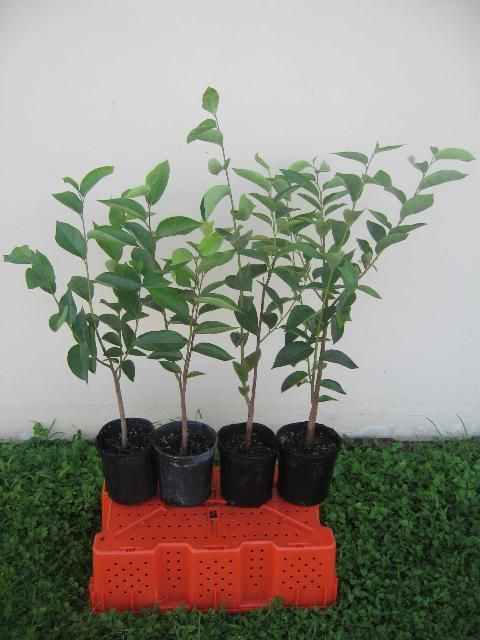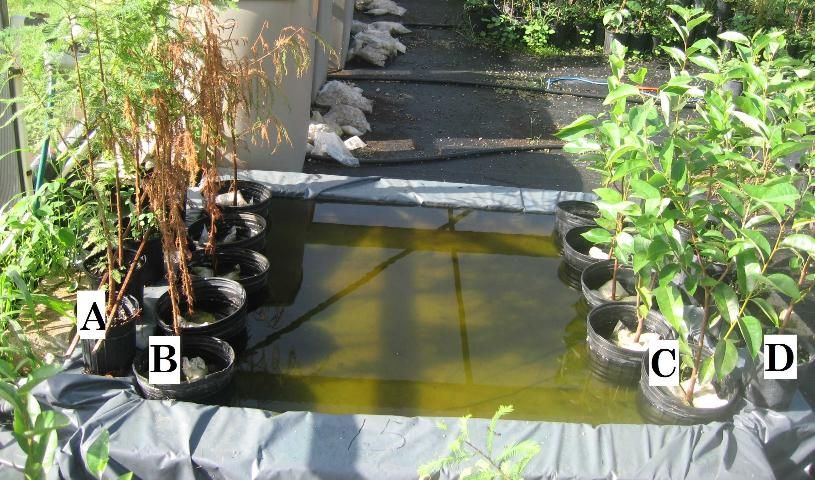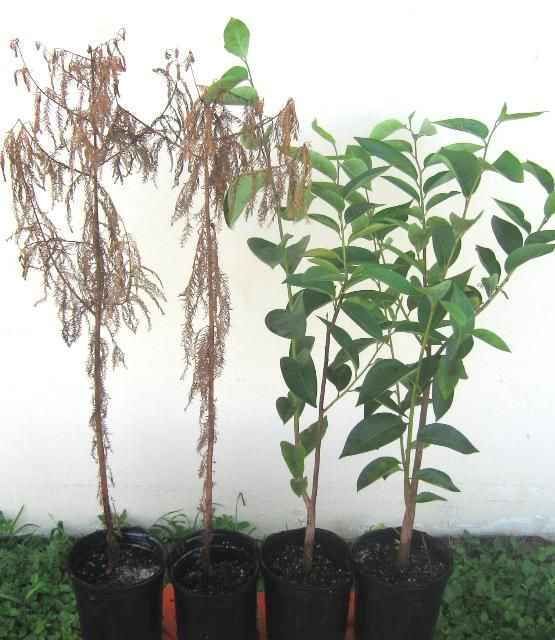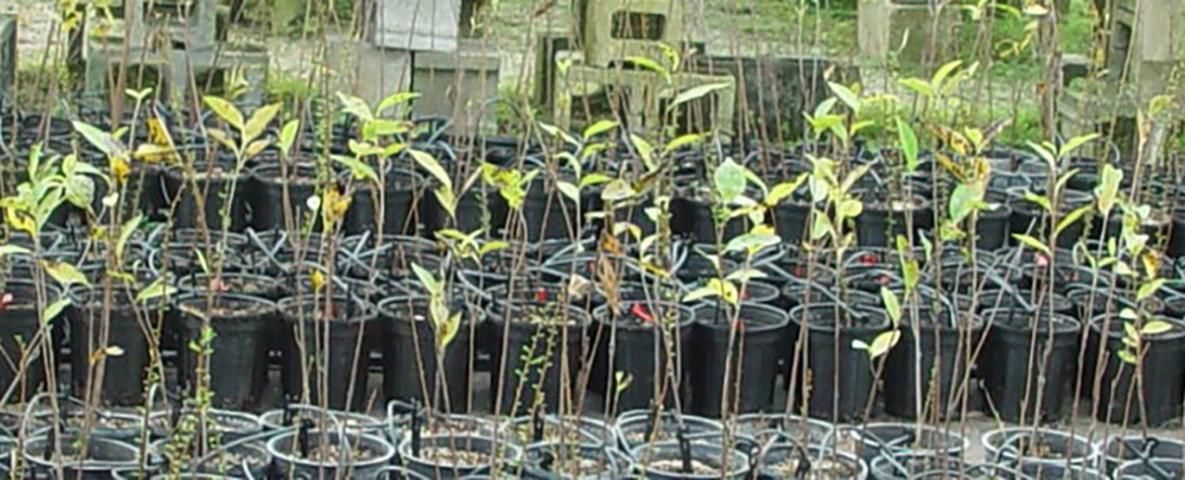Soil salinity is a naturally occurring problem for growers, gardeners, and homeowners in Florida. As sea-levels rise, seawater intrusion causes salt stress to plants grown in coastal lowland areas. The current practices for reducing salt stress are chemical strategies like oxygen fertilization and are only temporary solutions (Liu et al. 2016). The long-term approach must be a biological strategy that involves incorporating plant species that are adapted to salt stress. This article introduces a flood- and salt-tolerant species, pond apple (Annona glabra L.), which has great potential to be used in high-salinity coastal landscapes (Elisea et al. 2000).
Pond apple is a member of the custard apple family, Annonaceae (Núñez-Elisea et al. 2000). Figure 1 presents a photo of young pond apple plants. Pond apple is also called bobwood, corkwood, monkey apple, swamp apple, or alligator apple because American alligators often eat the fruit (Standley 1922). Feral pigs and other wild animals, including cassowaries, also consume this fruit, and the seeds are dispersed over great distances in their droppings (Austin 2001).

Credit: Guodong Liu, UF/IFAS
Pond apple, a semi-deciduous, woody tree, is native to mainland Florida. The Institute of Regional Conservation lists this species as a native species in south Florida (Gann et al. 2016). The USDA map of pond apple locations shows that this species is distributed only in Florida and Puerto Rico (http://plants.usda.gov/core/profile?symbol=ANGL4). The species can grow 10 feet or taller. The plant has alternate leaves with an acute tip of 3–6 inches long and 1.5–2.5 inches wide with a prominent midrib. The leaves are light or dark green on the upper surface and paler on the underside. The flowers are white to light yellow, approximately 1 inch in diameter. They have six petals including three leathery ones outside and three smaller ones inside. The inner base of the flower is red. This species can bear fruit starting at two years. The fruit is edible and looks like a custard apple. The fruit size is like a mango, ranging from 2 to 6 inches. The fruit contains approximately 100 seeds resembling pumpkin seeds in both appearance and size (Austin 2001). The fruit of this species was an important food source for the early Native Americans and settlers. The fruit can be eaten raw, boiled, or made into jellies (Morton 1974; Allen et al. 2012). Seeds, bark, and leaves of this plant contain many potent chemicals including some of the alkaloids found in opium (Smith 2007), polyketide natural products (Bermejo et al. 2005), and activators of dopamine receptors (Millan et al. 2002). They can all be used pharmaceutically or medically (Austin 2001). Recent research suggests that pond apple plant extracts contain anticancer chemicals (Cochrane et al. 2008).
Pond apple and bald cypress [Taxodium distichum (L.) Rich] both grow well in flooding conditions such as in the Everglades. Their leaf morphology and water relations, however, are totally different. Pond apple's broad leaves have a thick wax layer on either the upper or under surface and have low transpiration rates. In contrast, bald cypress has a significantly smaller leaf area and a thin wax layer on both surfaces. The differing leaf morphology and the underlying physiological differences may be the mechanisms to make pond apple significantly more tolerant to salt stress than bald cypress (Figures 2 and 3).

Credit: Guodong Liu, UF/IFAS

Credit: Guodong Liu, UF/IFAS
Pond apple is very tolerant to brackish water conditions but vulnerable to low-iron stress. When this species is grown in dry conditions, the leaves turn yellow easily and rapidly due to iron deficiency (Figure 4). Thus, this species needs to be grown in soil with appropriate moisture. If the leaves turn yellow, iron fertilization is needed. To avoid or correct iron deficiency of the species, please read these EDIS publications on iron: Irony Deficiency in Palms (https://edis.ifas.ufl.edu/ep265), Iron (Fe) Nutrition in Plants (https://edis.ifas.ufl.edu/ss555), Understanding and Applying Chelated Fertilizers Effectively Based on Soil pH (https://edis.ifas.ufl.edu/hs1208) (Broschat 2011; Hochmuth 2014; Liu et al. 2015).

Credit: Guodong Liu, UF/IFAS
References
Austin, D. 2001. "Pond Apples." The Palmetto 21(1): 10–11. Accessed on June 10, 2022. http://www.fnps.org/assets/pdf/palmetto/austin_dr_dan_pond_apples_no_4_people__plant_interaction_series_discovering_fls_ethnobotany_vol_21_no_1_november_2001.pdf
Bermejo, A., B. Figadère, M.-C. Zafra-Polo, I. Barrachina, E. Estornell, D. Cortes. 2005. "Acetogenins from Annonaceae: Recent Progress in Isolation, Synthesis and Mechanisms of Action." Natural Product Reports 22(2): 269–303.
Broschat, T.K. 2011. Iron Deficiency in Palms. ENH 1013. Gainesville: University of Florida Institute of Food and Agricultural Sciences. Accessed on June 10, 2022. https://edis.ifas.ufl.edu/ep265
Cochrane, C.B., P.K. Nair, S.J. Melnick, A.P. Resek, C. Ramachandran. 2008. "Anticancer effects of Annona glabra plant extracts in human leukemia cell lines." Anticancer Research 28(2A): 965–71.
Gann, G.D., M.E. Abdo, J.W. Gann, G.D. Gann, Sr., S.W. Woodmansee, K.A. Bradley, E. Grahl and K.N. Hines. 2016. "Natives for your neighborhood: a program of the Institute for Reginal Conservation." Accessed on June 10, 2022. http://www.regionalconservation.org/beta/nfyn/plantdetail.asp?tx=Annoglab
Hochmuth, G. 2014. Iron (Fe) nutrition in plants. SL353. Gainesville: University of Florida Institute of Food and Agricultural Sciences. Accessed on June 10, 2022. https://edis.ifas.ufl.edu/ss555
Liu, G.D., E. Hanlon, and Y.C. Li. 2015. Understanding and Applying Chelated Fertilizers Effectively Based on Soil pH. HS1208. Gainesville: University of Florida Institute of Food and Agricultural Sciences. Accessed on June 10, 2022. https://edis.ifas.ufl.edu/hs1208
Liu, G.D., Y.C. Li, K. Moore, K. Gabel, L. Wu, and R. Muñoz-Carpena. 2016. How to Chemigate Salinity-Stressed Plants with Hydrogen Peroxide to Increase Survival and Growth Rates. HS1280. Gainesville: University of Florida Institute of Food and Agricultural Sciences. https://edis.ifas.ufl.edu/publication/HS1280
Millan, M.J., L. Maiofiss, D. Cussac, V. Audinot, J.A. Boutin, A. Newman-Tancredi. 2002. "Differential actions of antiparkinson agents at multiple classes of monoaminergic receptor. I. A multivariate analysis of the binding profiles of 14 drugs at 21 native and cloned human receptor subtypes." The Journal of Pharmacology and Experimental Therapeutics 303(2): 791–804. Accessed on June 10, 2022. http://jpet.aspetjournals.org/content/303/2/791
Morais, L. C. S. L., J. M. Barbosa-Filho, R. N. Almeida. 1998. "Central depressant effects of reticuline extracted from Ocotea duckei in rats and mice." Journal of Ethnopharmacology 62 (1): 57–61. Accessed on June 10, 2022. http://www.sciencedirect.com/science/article/pii/S0378874198000440?np=y
Morton, J. 1974. 500 Plants of South Florida. E.A. Seemann Publishing, Inc., Miami, FL. 163 pp.
Núñez-Elisea, R., Caldeira, M. L., Crane, J. H., Schaffer, B. 2000. Clonal propagation of pond apple (Annona glabra L.), a flood-tolerant rootstock for commercial Annona species. Proceedings of the Florida State Horticultural Society 2000 Vol.113 pp.15-16. Acccessed on June 10, 2022. https://www.cabdirect.org/cabdirect/abstract/20033139423
Smith, J.P. 2007. Plants & Civilization; An Introduction to the Interrelationships of Plants and People. Botanical Studies. Open Educational Resources and Data at Humboldt State University. Accessed on June 10, 2022. https://digitalcommons.humboldt.edu/cgi/viewcontent.cgi?article=1008&context=botany_jps
Standley, P. C. 1922. "Trees and Shrubs of Mexico". United States National Herbarium 23(2): 281–282.